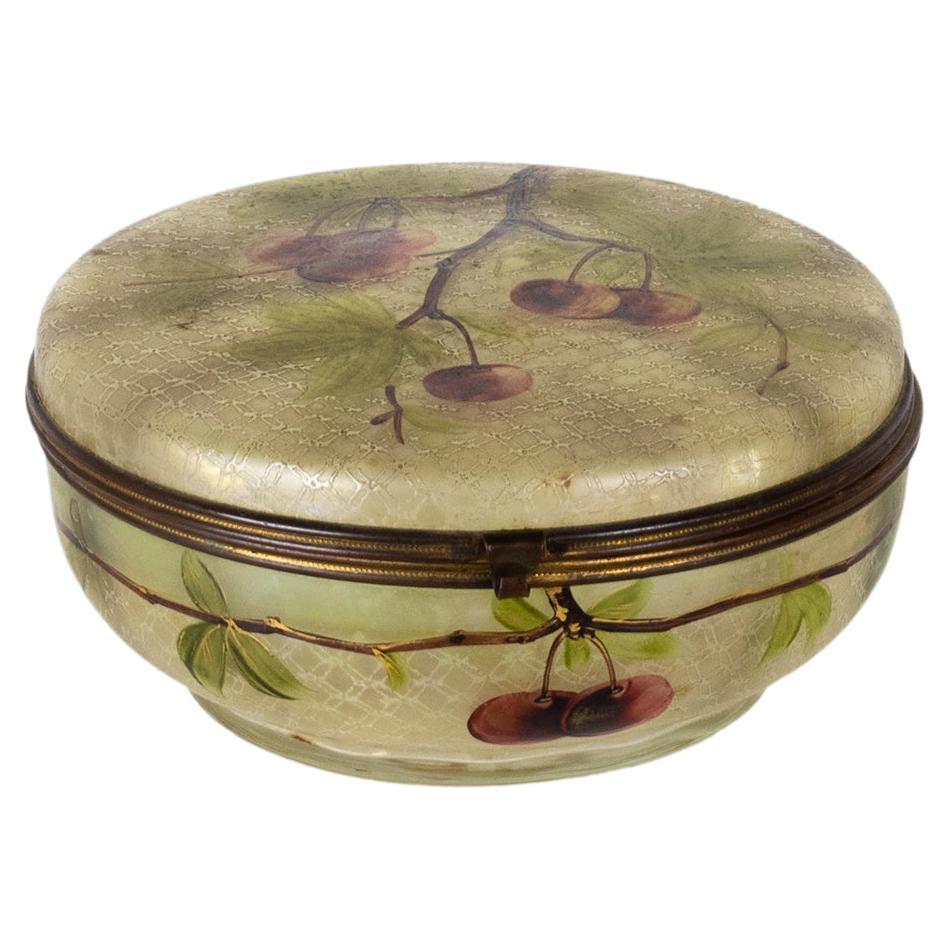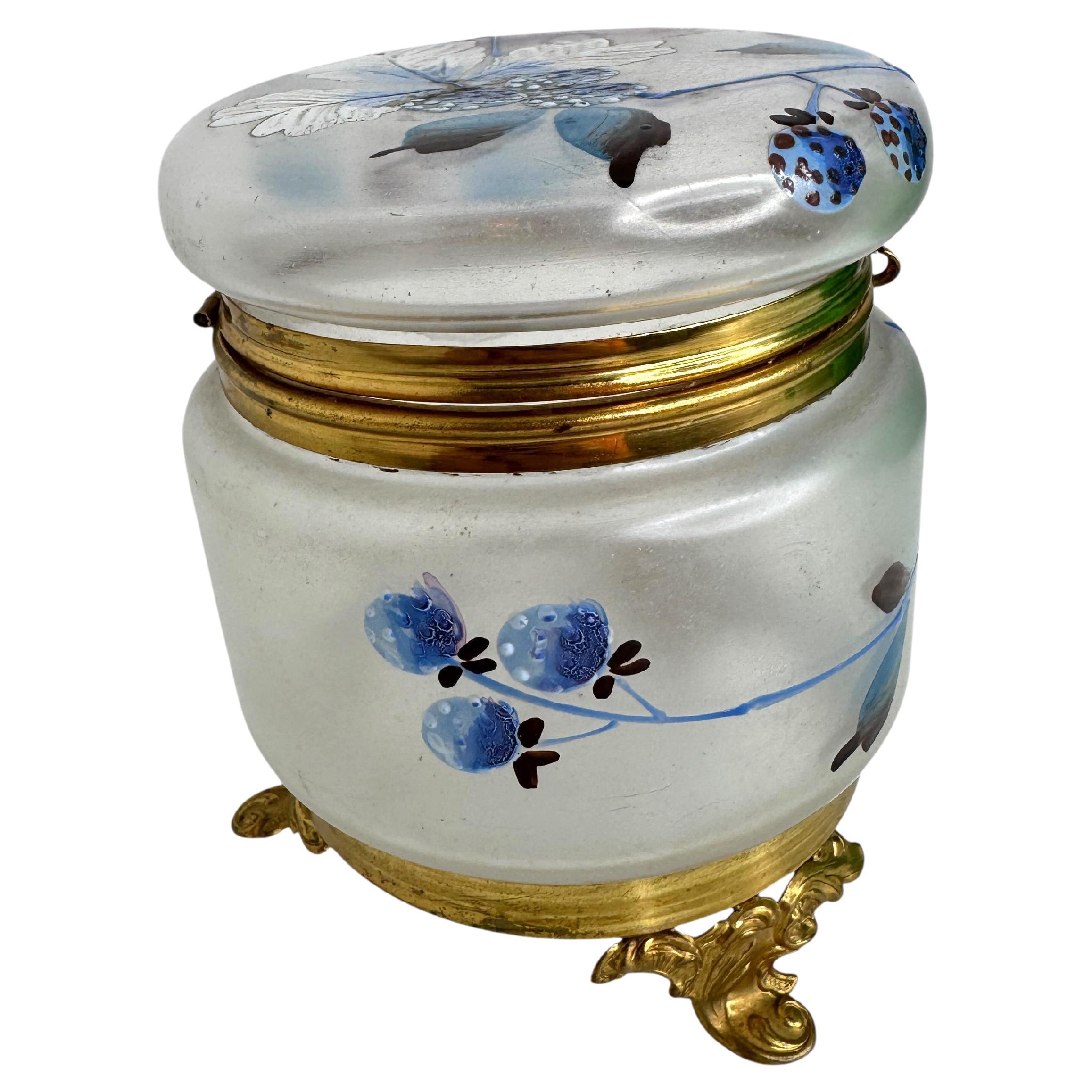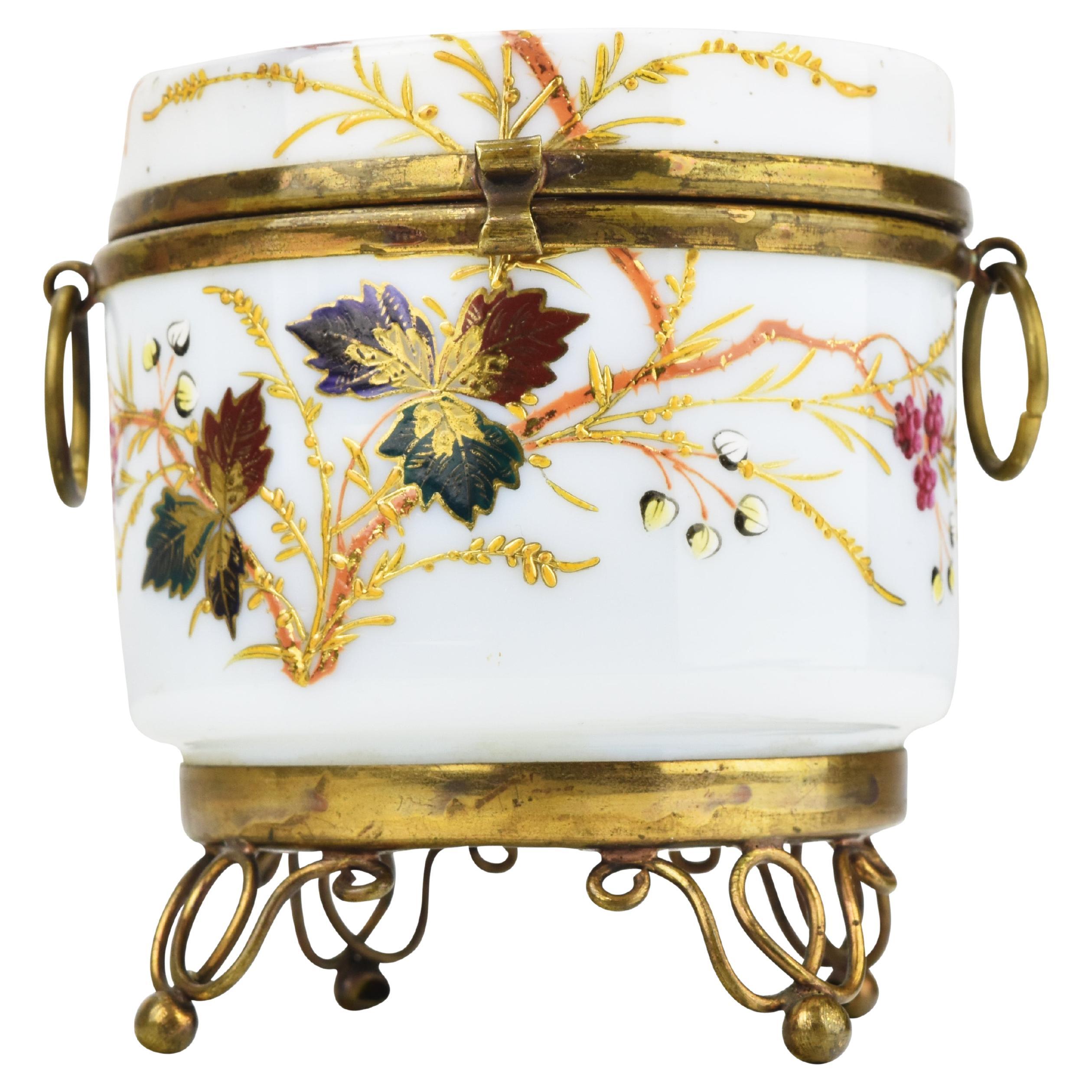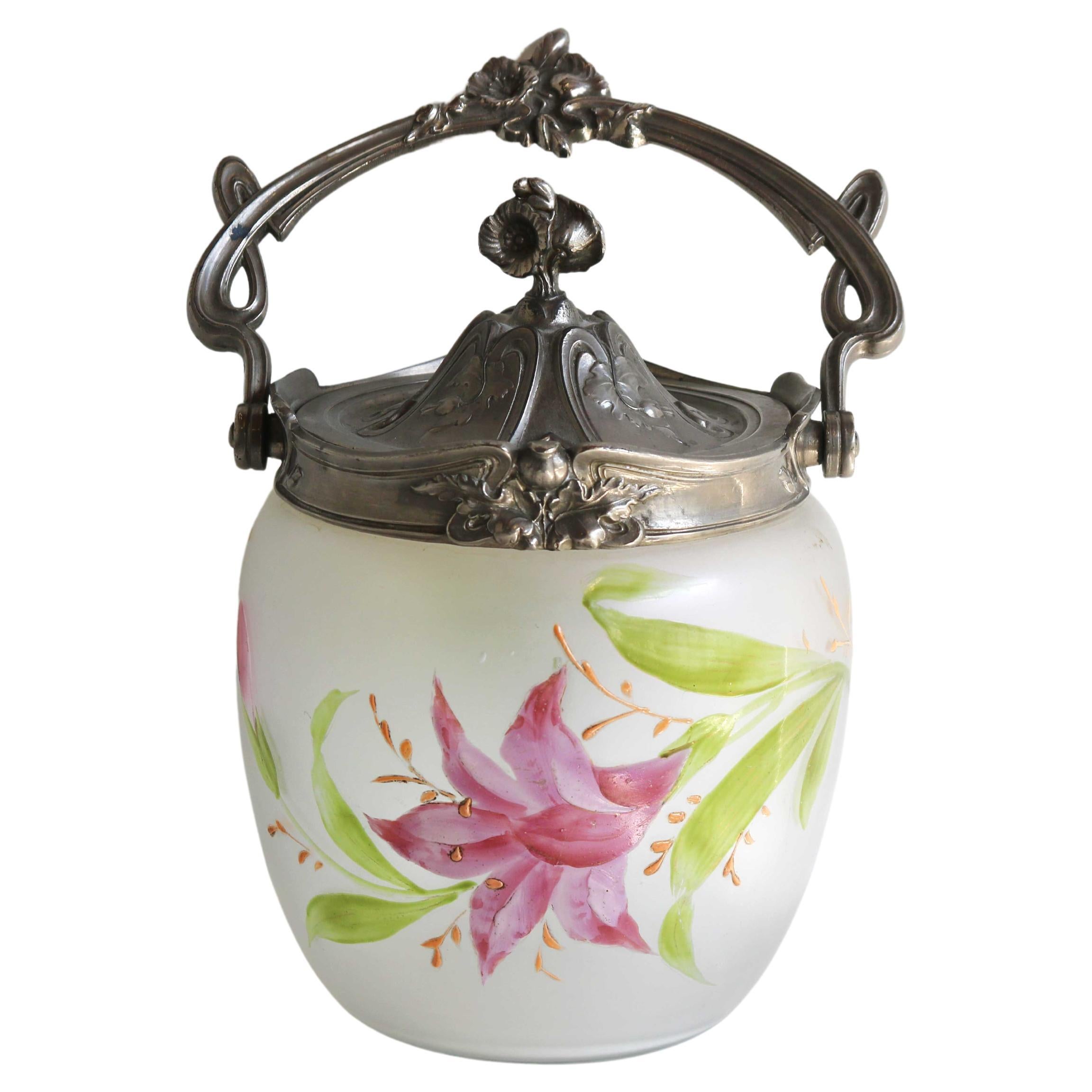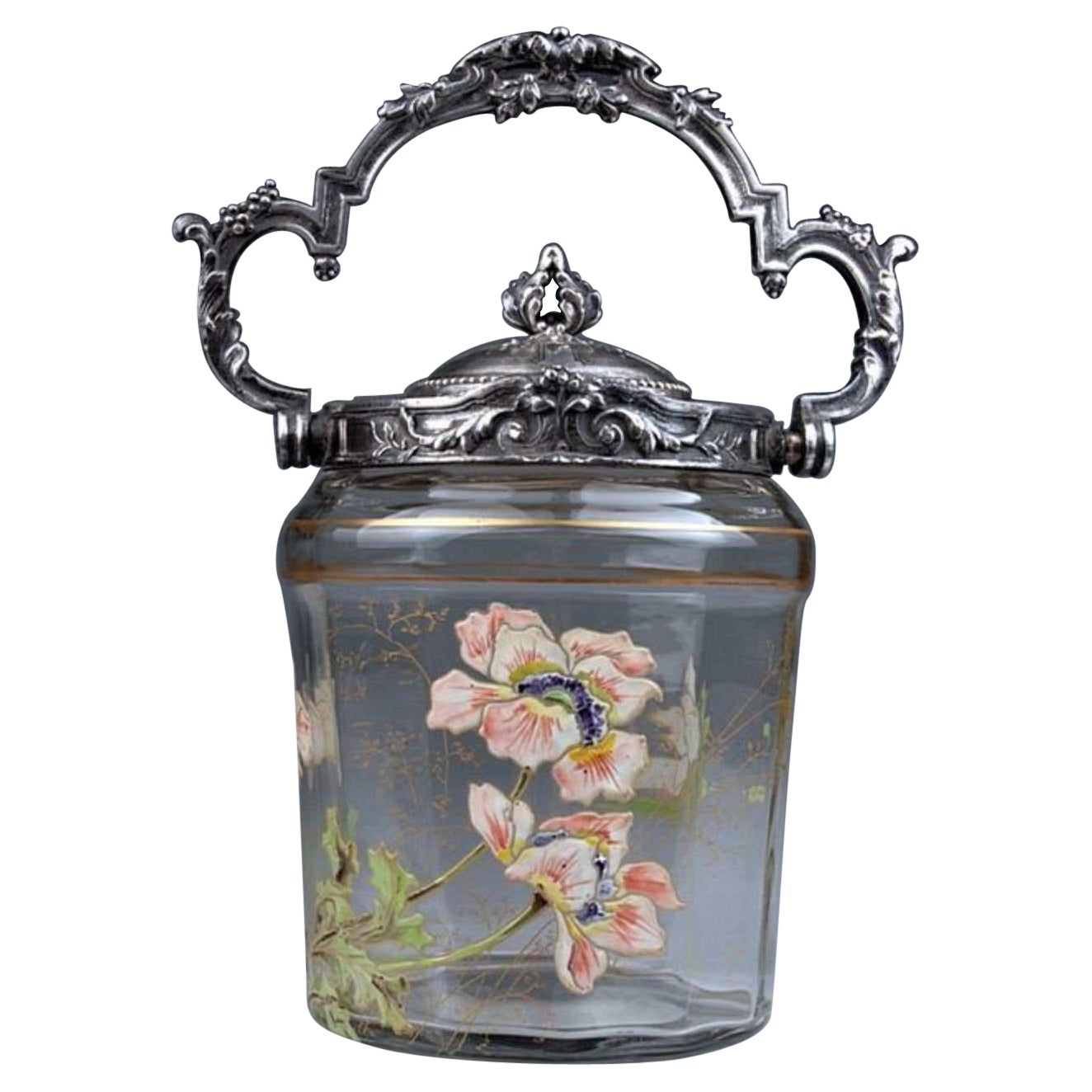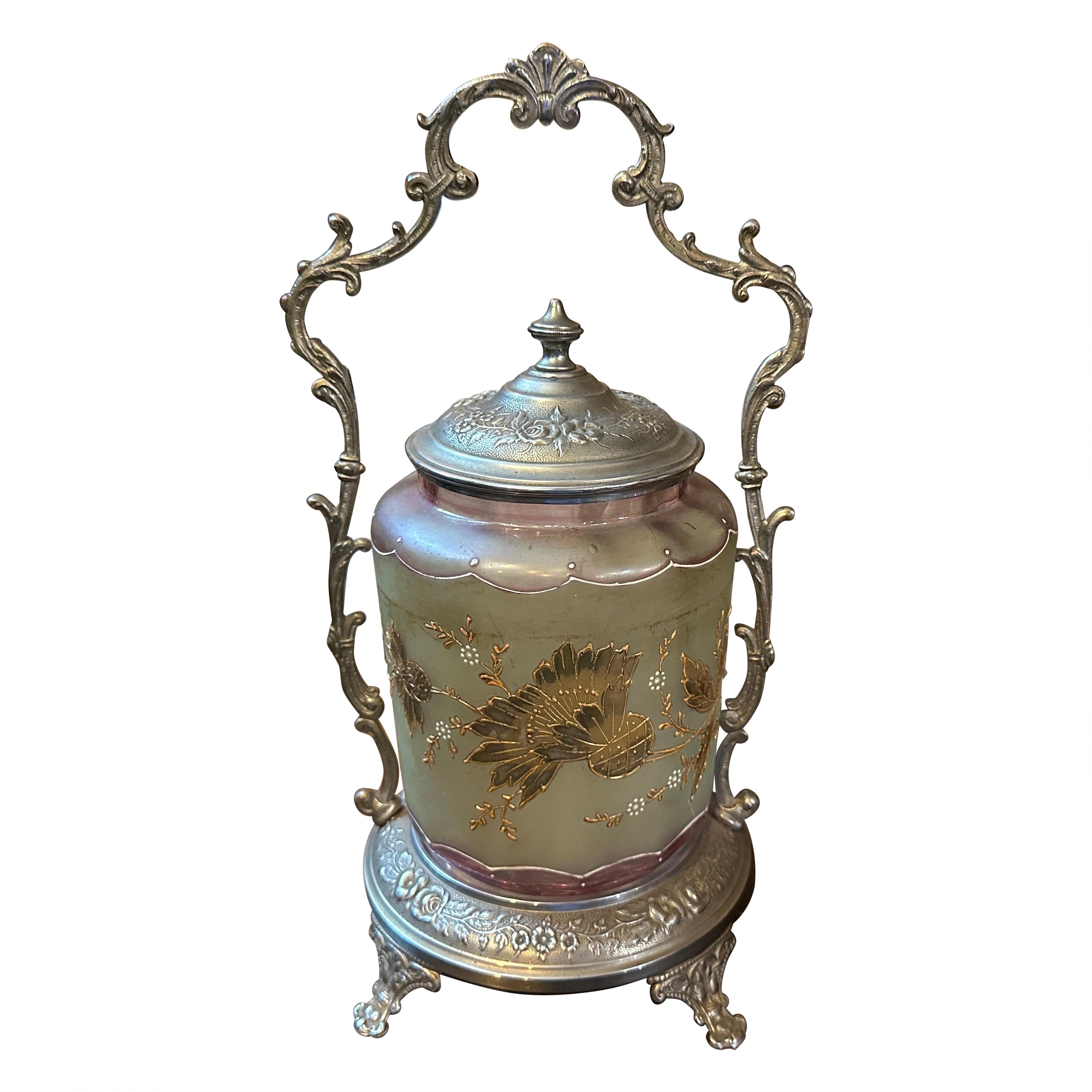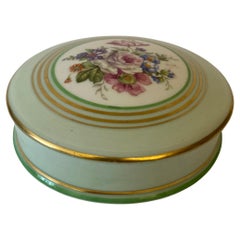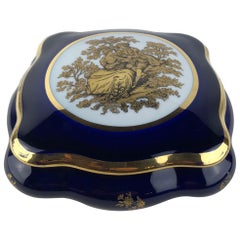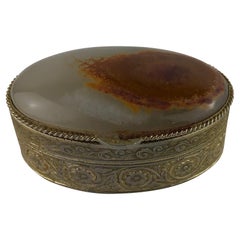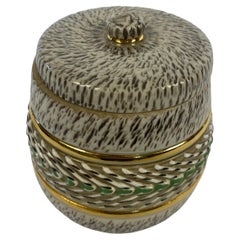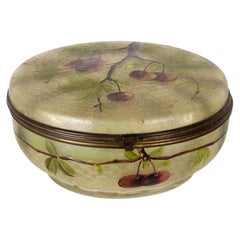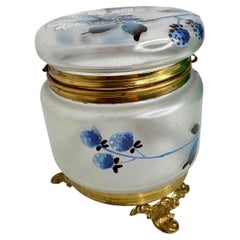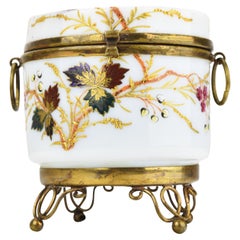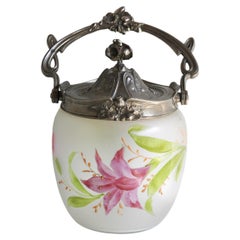Items Similar to French Art Nouveau Enameled Glass Trinket or Jewelry Box by Legras
Want more images or videos?
Request additional images or videos from the seller
1 of 5
French Art Nouveau Enameled Glass Trinket or Jewelry Box by Legras
$236
$29520% Off
£179.07
£223.8420% Off
€204.75
€255.9420% Off
CA$329.63
CA$412.0420% Off
A$366.50
A$458.1320% Off
CHF 191.37
CHF 239.2120% Off
MX$4,461.22
MX$5,576.5220% Off
NOK 2,441.76
NOK 3,052.2020% Off
SEK 2,287.81
SEK 2,859.7620% Off
DKK 1,528.10
DKK 1,910.1320% Off
Shipping
Retrieving quote...The 1stDibs Promise:
Authenticity Guarantee,
Money-Back Guarantee,
24-Hour Cancellation
About the Item
Beautiful hand decorated, Art Nouveau enameled glass trinket, or jewelry box. This is a gorgeous piece by Legras, makes a lovely gift to oneself or others.
Measures: 4 1/8" Diameter x 3 1/4" Height
Legras Art Glass History:
The Legras glassworks – ultimately a multi-centered concern employing hundreds of people across several manufacturing centers – produced enough highly-distinctive pieces to be considered an art-glass movement in its own right.
It’s more accurate, of course, to consider the name one of the foremost in the panoply of innovative, experimental and overtly artistic producers who revolutionized decorative glassware from the mid 1860's, throughout the fin de siècle, across the duration of the Great War and beyond.
The founding father of the company, François-Théodore Legras, came from humble stock, having begun life as a woodsman in the Vosges department south of Strasbourg. In 1859, Legras determined that there was potentially more to life than trees and leaves, and secured himself a clerical apprenticeship at the glassworks in Clairey, a long-established manufactory producing drinking glasses and tableware which – crucially for Legras – included the manufacture of crudely-frosted pieces.
After learning his trade for five years, Legras moved to Paris and took a job at the Plaine St Denis factory, securing a senior managerial role by the age of 27. He was director of the works when, underwritten by expat-philanthropist Sir Richard Wallace, it was significantly extended and modernized; the duo also took over another factory at Pantin, on the northern fringes of the city.
Unrestrained by the financial strictures of facilities lacking patrons such as Wallace, Legras was able to encourage an experimental approach to glass production, harking back to his childhood in the Darney Forests and using opaque glass – based on Clairey’s frosted material – as a canvas on which designs could be created. The businesses were also underwritten by the production of utilitarian glassware for industry – distilleries and pharmacies – and this security gave François-Théodore the freedom to develop his art-glass production techniques. Intricately cut cameo glass pieces, acid-etched and enameled imagery – requiring up to five separate firing processes to achieve the desired effect – became the Legras hallmark, with many pieces featuring forested landscapes and the favored themes of the artistic director - irises, orchids and chrysanthemums.
Additional members of the Legras family were apprenticed in to the company, notably a nephew – Charles – whose expertise in the chemical treatment of glass to produce marbled, opaline surfaces on which designs could be overlayed, was to prove a valuable commodity. Charles was ultimately to take over the running of the businesses in 1909, seven years before the death of his uncle. He was able to maintain a level of innovation which sustained the company for another decade – achieving notable successes in developing synthesized “gemstones” which could be ground up and incorporated in to the glass melt to give an extraordinary depth of colouration which provided the base for the production of striking cameo vessels.
A second nephew, Theodore, took over the running of the company after Charles’ death in 1922, but the quality and volume of outturn began to decline, and the operation passed out of the family’s hands in 1928, transferring to Heiligenstein, Souchon-Neuvessel and Francois Coty in turn – all of whom continued to produce material under the Legras name, trading on the reputation left by an extraordinarily rich and varied back-catalogue of wares left by six decades of superlative craftsmanship.
- Dimensions:Height: 3.25 in (8.26 cm)Diameter: 4.13 in (10.5 cm)
- Style:Art Nouveau (Of the Period)
- Materials and Techniques:
- Place of Origin:
- Period:
- Date of Manufacture:20th Century
- Condition:Wear consistent with age and use. Minor fading. Overall good vintage condition. Minor fading to the bottom and brass rim.
- Seller Location:Miami, FL
- Reference Number:1stDibs: LU4082120848032
About the Seller
4.9
Gold Seller
Premium sellers maintaining a 4.3+ rating and 24-hour response times
Established in 2014
1stDibs seller since 2018
570 sales on 1stDibs
Typical response time: 2 hours
- ShippingRetrieving quote...Shipping from: Miami, FL
- Return Policy
Authenticity Guarantee
In the unlikely event there’s an issue with an item’s authenticity, contact us within 1 year for a full refund. DetailsMoney-Back Guarantee
If your item is not as described, is damaged in transit, or does not arrive, contact us within 7 days for a full refund. Details24-Hour Cancellation
You have a 24-hour grace period in which to reconsider your purchase, with no questions asked.Vetted Professional Sellers
Our world-class sellers must adhere to strict standards for service and quality, maintaining the integrity of our listings.Price-Match Guarantee
If you find that a seller listed the same item for a lower price elsewhere, we’ll match it.Trusted Global Delivery
Our best-in-class carrier network provides specialized shipping options worldwide, including custom delivery.More From This Seller
View AllAntique Limoges Porcelain Jewelry Box or Lidded Candy Dish
By Limoges
Located in Miami, FL
Beautiful Limoges porcelain hand crafted and hand painted gold trimmed trinket, jewelry box or lidded candy dish, circa 1930.
Marked, see photos.
...
Category
Early 20th Century French Mid-Century Modern Jewelry Boxes
Materials
Porcelain
$295 Sale Price
26% Off
Limoges Porcelain Lidded Candy Dish Trinket or Jewelry Box French
Located in Miami, FL
Beautiful hand painted Limoges porcelain candy dish, trinket, or jewelry box.
This gorgeous French jewelry box is adorned with traditional decor...
Category
20th Century French Napoleon III Porcelain
Materials
Porcelain
$395 Sale Price
20% Off
French Neoclassical Lidded Pill, Trinket or Small Jewelry Box
Located in Miami, FL
Beautiful handcrafted lidded pill, trinket, or small jewelry box.
Intricately designed brass bottom, amber and quartz top.
Makes a lovely gif...
Category
20th Century French Porcelain
Materials
Quartz, Brass
$225 Sale Price
23% Off
French Ceramic Jewelry Box Signed Lucien Brisdoux
By Lucien Brisdoux
Located in Miami, FL
A very nice quality mid-century French ceramic jewelry box or decorative lidded box.
This hand-crafted, hand-painted mid-century French box would look great on a small side table o...
Category
Mid-20th Century French Tobacco Accessories
Materials
Ceramic
$556 Sale Price
20% Off
French Limoges Hand Painted Gold Trim Trinket Jewelry Box or Candy Dish
By Limoges
Located in Miami, FL
Beautiful Limoges handcrafted and hand painted gold trimmed trinket, jewelry box or candy dish, circa 1930.
Signed, Jammet Seignolles Limoges (history of this maker below).
Glazed.
Measures: 4 3/8" Diameter x 2 1/4" high.
Very good antique condition, no cracks or chips.
In 1825, François BAIGNOL moved to LA FABRIQUE, on the edge of the Brigueuil forest and founded...
Category
Early 20th Century French Napoleon III Serving Pieces
Materials
Porcelain
$360 Sale Price
48% Off
French Hand-Crafted and Painted Ceramic Trinket or Jewelry Box
Located in Miami, FL
A beautiful hand-crafted ceramic lidded trinket or jewelry box.
Mid-20th century, French.
Used as decorative item, this piece would enhance any shelf or tabletop.
Measures: 6 1/8...
Category
Mid-20th Century French Mid-Century Modern Tobacco Accessories
Materials
Ceramic
$495 Sale Price
23% Off
You May Also Like
Art Nouveau Enameled Glass Jewelry Box, 1900s
Located in Lisbon, PT
This delicate French Art Nouveau enameled glass jewelry box features hand-painted cherry fruits and leafy branches, capturing the romantic elegance of ...
Category
20th Century French Art Nouveau Jewelry Boxes
Materials
Brass, Enamel
$1,623 Sale Price
20% Off
Art Nouveau Ormolu and Satin Glass Trinket Jewelry Box, France, circa 1900s
Located in Nuernberg, DE
A gorgeous glass trinket box with ormolu mounts. No restoration has been carried out on this charming little trinket box, which remains in very stabile and functioning condition, wea...
Category
Antique Early 1900s French Art Nouveau Jewelry Boxes
Materials
Ormolu
Antique Victorian Jewelry Box French Opaline Glass Hand-Painted Art Nouveau
By Legras & Cie, Legras Montjoye
Located in Bad Säckingen, DE
This antique Victorian opaline glass jewelry casket is a true testament to the opulence and elegance of the era.
The pièce de résistance is undoubtedly its exquisite floral enamel p...
Category
Antique 1880s French Victorian Jewelry Boxes
Materials
Enamel
$1,151 Sale Price
39% Off
Antique Floral Hand Painted Enameled Glass Biscuit Box, Art Nouveau, France
Located in Ijzendijke, NL
Antique floral glass biscuit barrel / cookie jar with Art Nouveau Enamel Decoration, France 1890-1919
An antique biscuit jar of frosted, satin g...
Category
Early 20th Century French Art Nouveau Tableware
Materials
Metal
Antique Biscuit Box, by Armand Fresnais, Art Nouveau Hand-Painted Glass, France
By Armand Fresnais
Located in Ijzendijke, NL
Antique Silver-plated Biscuit Box ,By Armand Fresnais, Art Nouveau Hand-Painted Glass , France 1877-1927
A gorgeous Art Nouveau cake container/ biscuit box. Thick, hand-painted glas...
Category
Early 20th Century French Art Nouveau Jars
Materials
Silver Plate
An Art Nouveau Metal and Art Glass French Biscuit Box
Located in Catania, Sicilia
This Art Nouveau French biscuit box is a striking example of the elegance and craftsmanship characteristic of the Art Nouveau movement. The biscuit box typically features a metal bas...
Category
Early 20th Century French Art Nouveau Decorative Boxes
Materials
Metal
More Ways To Browse
Glass Jewellery
Iris Glass
Box Opaline
Art Nouveau Enameled Silver Jewelry
Chrysanthemum Porcelain
Art Nouveau Silver Overlay
Etched Glass Jewelry
Francois Jewelry Vintage
Vintage Iris Glass
Chrysanthemum Jewelry
Porcelain Iris
Porcelain Cameo
Silver Overlay Porcelain
Cameo 1860s
Alabaster Trinket
Alabaster Trinket Box
Legras Cameo Glass
Vintage Alabaster Trinket Box
